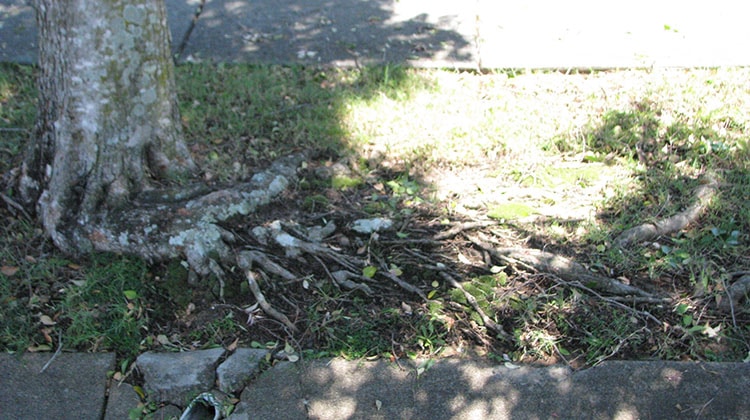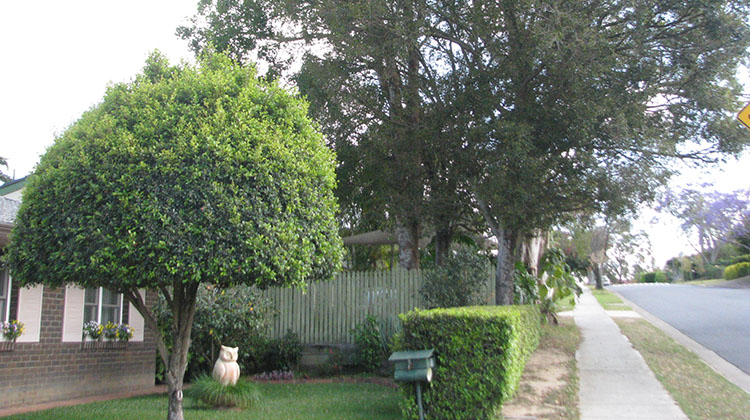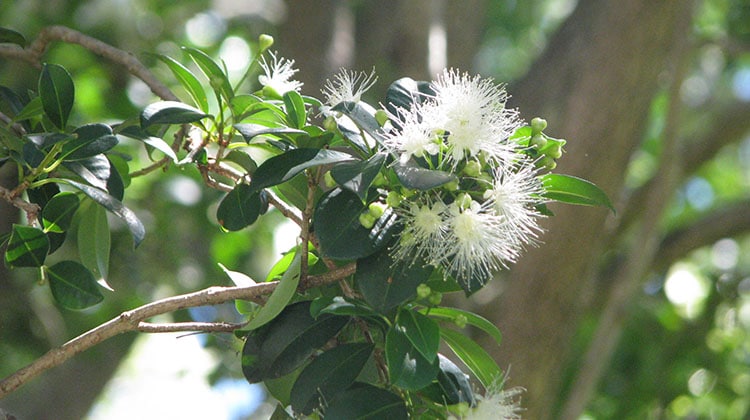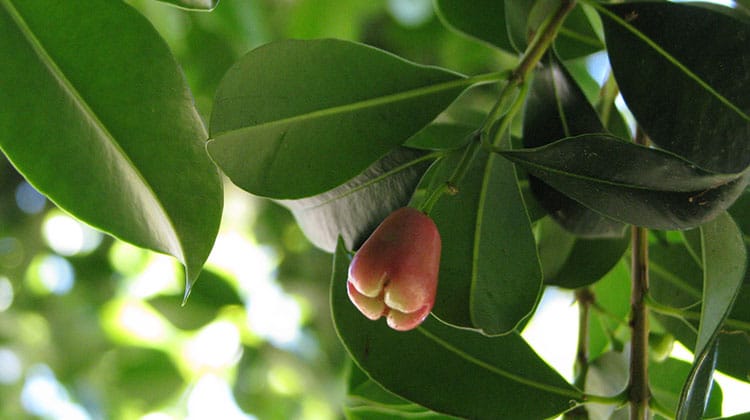Syzyigium australe
Family: Myrtaceae Origin: Eastern Australia
A very popular and native Australian tree, this wonderful (usually) tree is grown in lots of ways. It has been bred into many cultivars suitable for many uses in the garden. Lillypilly can have a lot of names and has been misnamed many times because of the range of cultivars it comes in. Names like Brush Cherry, Scrub Cherry, creek satinash, watergum, and creek lilly-pilly are all names that this tree has had. Shorter and more compact cultivars of lillypilly are more popular than larger ones, as they can be grown in pots and easily controlled. Larger cultivars and the wild cultivars of lillypilly have been known to have destructive and aggressive root systems so some caution is required when locating a suitable place for their cultivation.
 Arboriculture
Arboriculture
Growth Form
Usually, cultivars have a pleasant upright and dense growth form that take happily to pruning and shearing. In the wild, individual specimens can reach 35 metres in height. They are dense and upright and columnar when young and grow openly as they age. Usually planted in the landscape as close growing hedges, here they take on any form of topiary that’s wished of them.
 Trunk
Trunk
In cultivation, trunks are usually unseen as the bush itself reaches to the ground as a hedge. But, the tree itself can have a trunk of up to 60 cm in diameter.
Flowering
The flowers of the lillypilly are white and fluffy and form in clusters. They are very attractive to pollinators and have a nice smell.
 Foliage
Foliage
The leaves are dark green and evergreen. In many cultivars new growth leaves are brightly colored in red and purple or yellow and chartreuse.
Fruits
The fruit of the lillypilly is very attractive to people and is enjoyed fresh, but is usually cooked and eaten in jams and jellies. Each fruit is long lasting and bright red or pink when ripe.
 Management
Management
Propagation
Lillypilly is normally propagated by seed in the wild, but cultivars are all propagated asexually by taking cuttings. This is the best way to ensure that the phenotypes (the look and form) of specific lillypilly plants are perfectly copied into offspring baby plants.
Cultivation
This little tree makes a great hedge and can be treated as such, as it takes to pruning and shearing and shaping happily- and this is the normal use of it in the home landscape. Give lillypilly full sun, adequate moisture and regular feedings of all-purpose food and it’ll stay healthy for many years. In some cultivars and the wild types, the roots are aggressive in their search for water. Underground, any leaky pipe of puddling water against a foundation will attract a root and roots aren’t shy about taking what they think is theirs, sometimes creating damage. There are cultivars with tame root systems, so purchasing these nicer cultivars is a good idea if you plan to use lillypilly near foundations or landscaping. Given lots of space, the wild type of lillypilly with its very delicious fruit make it an excellent homestead tree for an edible landscape.
If you are located in Brisbane and need help with Lillypilly pruning or root control, please contact us for a free assessment.

Hi , I have some tree stumps in ground that are cut down to ground level , can I plant a lily pily resilient directly beside stump , then poison the stump so it does ? Stumps are about 300-400mm in diameter
Thanks
Hi,
We have the choice to plant either 3 weeping Lilly pillys or 3 tulipwoods outside on our corner block. Full sun and no pipes or anything interfering. Which trees would be best? Both sound and look nice but we park our cars out on the street so don’t want seeds and leaves dropping on them. Any advice would be great thank you:)
Hi, our Lilly Pilly tree appears to be dying off in some sections and developing woody branches, bare of leaves. Sections of the trunk has cracked bark. I’m wondering how I can save it. The ground is moist and cannot see evidence of borers. Thanks
I’ve planted some lilly pillies in planters at the front of my apartment. The planters are quite deep at about 70cm and wide, being up to 70cm for each lilly pilly. I’m wondering how to achieve optimal growth in this situation as I want to screen off the traffic and passersby that go along the road and footpath. I’m hoping they will grow up to a metre high.
How often should I be fertilizing them? T
Thanks!
Hi we have quiet a large Lillie pillie in our back yard. We have noticed a crack in our footpath and quiet a large one in our Pergola.we planted the tree as a small plant 23 years ago. The height now is around 8-10 metre,our pergola is approx 9.5 metres from the tree base. we look forward to you reply so we can possibly attach some pics of the tree.
How long do Lilly Pilly “ Resilience” live? I seem to have mixed results with some site saying only 20 year lifespan and others saying 100-200+ years lifespan. Does anyone know their approx lifespan??
Thank you
I have a beautiful big LillyPilly tree in my yard in Brisbane which is about 10 metres tall and about 25 years old. It is losing its leaves at an alarming rate now – it has never shed its leaves before. There appear to be new leaves growing , but the tree if definitely thinning out. It is near the sewage pipe so has always been very lush. We have been running the hose on its roots thinking may be it was the drought, but it is still losing leaves. How long do LillyPilly trees usually live?
Many thanks
Jennifer
Hello Jennifer – you might want to check out the green calypso beetle as a possible source of your Lilly pills problem.
Roots in pipes are now less of a problem due to the advent of the video which plumbers use. This “camera on a hose” tells exactly what is happening inside your pipes. No need to dig. No need to speculate. No need to pay for work not needed.
will lilly pillys regrow if I trim them back to above ground level as I have some that have no foliage from nearly fence height to the ground any advice would be great thanks
Hi David, I would be interested in knowing more about how the Lillipilly can be planted. I have one in my backyard and it drops fruit, which seems to self germinate quite easily. I have not kept track of how long it takes for it to sprout and then develop further. I work with children in primary school, and at the moment doing an assignment re life cycle, including plants. It would be a good project to use the Lillipilly, if it grows fast enough, so that the children can notice the difference.
our neighbour has several lillypillies growing along the fence , but these have roots that are coming into our garden and under the fence heading to our house they have cracked the concrete path. my husband is digging a trench to put root barrier in but he keeps coming upon roots and more roots, We are wondering how deep these could be ,we have askes him to trim the trees and shown him the roots he said they were at the house when he bought it 10years ago looking forward to your answer and any suggestions you have thank you
What a great article – lots of helpful information there. I have recently purchased 5 acmena smithii minor lilly pilly’s to plant along my back border. My Neighbour’s garden is below the height of my garden by about 2 metres and I believe that there is a sewage pipe along the back wall, below where I intend on growing my hedge. Do you think there will be issues with the root system getting into the sewage pipe? If so, do you think I could get a 3+m high hedge if I create a raised bed for the lilly pillys? Do you have any ideas what dimensions that bed would need to be to get that height of plant?
Thanks in advance,
Dunc
Hi Duncan. You can easily get a 3m high hedge even from ground level since A. smithii minor grows to 5m. I can’t guarantee your trees won’t find your pipes, though most problems from small trees are caused by pipes cracking first then being clogged with roots.
If you had wild Lillypillies from North Queensland it would be a different story. The original species could break concrete. These cultivars are much tamer.
I like eating lillypilly fruits straight off the tree, but never thought to make jam from it.